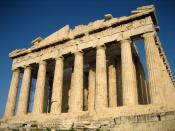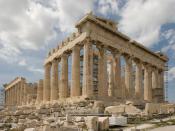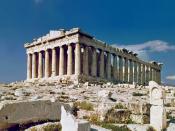Classical and Gothic Architecture
�
�
The cultures of the ancient Greeks and medieval Europeans were significantly influenced by religion. Greek Classicism brought about some of the most beautiful artwork and architecture that still exists today. The style strives to exemplify a culture of harmony, order, reason, intellect, objectivity, and formal discipline (Sporre, 2010). Classicism is best exemplified in the ancient temples that are found throughout the region of Greece and Italy. Gothic style art and architecture began in the areas surrounding Paris in the sixteenth century (Sporre, 2010). Similarly, the Gothic architecture of the late medieval era is best exemplified in places of worship. The Gothic cathedral is described by Sporre (2010) as a, "synthesis of intellect, spirituality, and engineering, perfectly expressing the medieval mind"(p.242). There are significant similarities between Classical and Gothic architecture, both also some noteworthy differences; however, no matter the result of comparison, both styles have left the world with beautiful architectural achievements.
The Parthenon in Greece is one of the best examples of Greek Classicism. Built on the Athenian Acropolis, this temple was dedicated to the Greek goddess Athena, the goddess of wisdom, courage, inspiration, skill, and strength. The precision and symmetry of the Parthenon has been called the culmination of the Doric order and is largely considered one of the world's greatest cultural monuments. The Parthenon was completed in 438 BC and is one of the most elegant (and ancient) examples of post-and-lintel creations (Sporre, 2010). The Parthenon is also a peripteral temple, in which columns surround the interior room (Sporre, 2010). The composition of the temple beautifully typifies the classical style and the Doric character; it achieves harmony through its clean simplistic configuration. The Doric order is best recognized by the capitols that rest the lintels of a classical column. The Parthenon easily...


